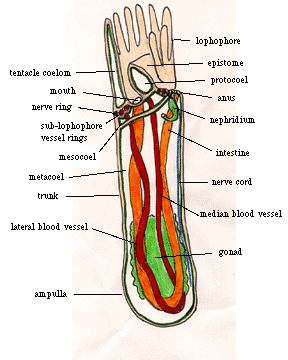Phoronids facts for kids
Quick facts for kids Phoronids |
|
|---|---|
 |
|
| Scientific classification | |
| Genera | |
The number and identification of species is uncertain. |
The Phoronida, also known as horseshoe worms, are a small group of marine animals. There are about twenty different species of these worms, found in two main genera.
Phoronids are shaped like worms, but they have a special feature: their gut loops around and opens near their mouth. This U-shaped gut is why they are called 'horseshoe worms'. You can find them in all oceans and seas, except for the very cold polar regions. All species of phoronids live in many different places around the world.
They live at depths up to 400 metres (about 1,300 feet), but most prefer shallower waters, between 0 and 70 metres (0 to 230 feet). Scientists believe they live for about one year. Adult phoronids are tube worms. This means they build and live inside tubes made of a tough material called chitin. These tubes can be buried in mud or sand. They can also attach to the surface of rocky areas. If they live on rocks, they might form colonies. Their tubes twist together to help support each other. Some phoronids can even make holes in rocks like limestone, seashells, or even cement piers. They then line these holes with their tubes and live inside.
Phoronids eat using a special part called a lophophore. This is a crown of tentacles with tiny hairs called cilia that surrounds their mouth. Phoronids, along with Bryozoa and Brachiopoda, are part of a larger group called lophophorates. Sometimes, all these animals are even grouped into a single phylum.
Contents
Anatomy of a Horseshoe Worm
Even though they can be quite long, up to 50 centimeters (about 20 inches), phoronids are usually very thin.
The digestive system of a phoronid starts with a short tube called an oesophagus. This leads to a round stomach, and then to the intestines. The intestine ends at the anus, which is located near the mouth. Phoronids have a simple blood system. It has one main vessel that carries blood down and another that carries it up. These are connected by a network of tiny capillaries. There are also blood vessels that go into each of their tentacles. Their blood is clear, but it contains special cells with a pigment similar to haemoglobin. This pigment helps the blood carry oxygen.
The nervous system is mainly made up of a nerve cluster called a ganglion. This ganglion is located between the mouth and the anus. There is also a ring of nerves at the base of the lophophore. One or two large nerve fibres extend from the ganglion along the body wall. Phoronids also have two tube-shaped excretory organs. These organs release waste outside the body through small openings called nephridiopores, which are on a small bump near the anus.
Reproduction and Life Cycle
Phoronids can be hermaphrodites, meaning they have both male and female reproductive parts. Some species have separate sexes. They can also reproduce without a partner, which is called asexual reproduction. Reproductive cells, called Gametes, are released through the excretory organs. Fertilization (when sperm meets egg) likely happens inside the worm's body.
Phoronids have two main ways of reproducing:
- Some species, like Phoronis ovalis, lay only a few large eggs (12–25). These eggs have a lot of yolk, which provides food for the developing worm. The adult worm keeps these eggs safe inside its tube until they hatch.
- Other species lay many more smaller eggs (up to 500). These eggs are released into the water as soon as they are fertilized. They hatch a few days later into tiny swimming creatures called 'actinotrocha' larvae. These larvae float in the plankton for about 2–3 weeks. After about 20 days, they settle down. Then, they go through a very fast change called Metamorphosis. This change happens in less than 30 minutes, turning the larva into a slender young phoronid worm.
Phoronids have an amazing ability to regenerate. If their lophophore gets damaged, they can grow a new one. In fact, Phoronis ovalis actually loses its lophophore on purpose to lay its eggs! Once the eggs are laid, the animal simply grows a new lophophore.
How Horseshoe Worms Eat
Phoronids are suspension-feeders. This means they filter tiny food particles from the water. They move their lophophores into the water current. Food particles in the water get caught in a sticky stream of mucus. This mucus travels along the tentacles until it reaches a ring around the mouth. From there, the food is pulled into the mouth and then into the digestive system. Phoronids can also absorb amino acids directly through their skin.
Ancient Horseshoe Worms
We don't have many fossils of phoronids. However, there are some holes found in rocks from the Devonian period (a very long time ago) that scientists think were made by ancient phoronids. A fossil called Iotuba chengjiangensis, found in the Lower Cambrian period, might also be a phoronid. It seems to have had a U-shaped gut and tentacles, just like modern phoronids. Phoronids might also be related to some common but mysterious tube-shaped fossils called hederellids.
Images for kids
See also
 In Spanish: Phoronida para niños
In Spanish: Phoronida para niños





